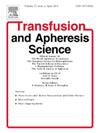Characterization of the practice of pretransfusion medication in the oncohematology unit and knowledge of physicians and nurses
IF 1.2
4区 医学
Q4 HEMATOLOGY
引用次数: 0
Abstract
Blood transfusion was a revolution in Medicine, however, the reactions transfusions permeates it. This study aimed to evaluate and characterize the practice of pretransfusion medication and perception of physicians and nurses regarding this approach. Data concerning premedication were collected from physical and electronic medical records of onco-hematologic patients throughout the year 2021. Semistructured interviews were conducted to assess the knowledge of prescribing physicians and nursing staff. During this period, there were 688 transfusion events in the Oncologyhematology Unit, with premedication being used in 522 cases (75.87 %), most frequently for platelet concentrates. The most commonly used classes of medications were antihistamines (52.3 %) followed by analgesics (28.7 %). The majority of physicians reported prescribing premedication in cases of previous transfusion reactions. The most frequently hemocomponent prescribed (80 %) was random platelet concentrates. Concerning specific medications, 60 % mentioned diphenhydramine and 40 % mentioned dipyrone. Regarding nursing staff, 50 % stated that premedication was employed in 70–80 % of transfusions; 70 % reported that antiallergics were the most commonly prescribed, consistent with physician responses. Only 40 % mentioned seeking alternative measures to premedication, such as bedside observation, and 90 % expressed reluctance to administer blood components without premedication. Our findings reveal a widespread practice of premedication, reflecting a conservative approach that is increasingly being questioned and challenged. The high rates of premedication underscore need for reformulation and adoption of protocols that encompass best medical practices and continuous pursuit of preventive strategies, including alternatives to premedication and even transfusion itself, emphasizing restrictive transfusion practices through proper patient management.
肿瘤血液科输血前用药的特点及医生和护士的知识
输血是医学上的一次革命,然而,输血的反应渗透了它。本研究旨在评估和描述输血前用药的实践,以及医生和护士对这种方法的看法。从2021年全年肿瘤血液病患者的物理和电子医疗记录中收集有关药物前治疗的数据。采用半结构化访谈来评估开处方的医生和护理人员的知识。在此期间,肿瘤血液科发生了688例输血事件,其中522例(75.87 %)使用了预用药,最常见的是血小板浓缩物。最常用的药物类别是抗组胺药(52.3% %),其次是镇痛药(28.7% %)。大多数医生报告说,在以前有输血反应的情况下,会开预用药处方。最常见的血液成分处方(80 %)是随机血小板浓缩物。在特定药物方面,60% %提到苯海拉明,40% %提到双吡咯酮。关于护理人员,50% %表示在70 - 80% %的输血中采用了预用药;70% 报告抗过敏药是最常用的处方,与医生的反应一致。只有40% %提到寻求替代药物治疗前的措施,如床边观察,90% %表示不愿意在没有药物治疗前使用血液成分。我们的研究结果揭示了药物前治疗的广泛实践,反映了一种日益受到质疑和挑战的保守方法。药物治疗前的高比率突出表明,需要重新制定和采用包括最佳医疗做法和不断追求预防战略的方案,包括替代药物治疗前甚至输血本身,强调通过适当的病人管理实行限制性输血做法。
本文章由计算机程序翻译,如有差异,请以英文原文为准。
求助全文
约1分钟内获得全文
求助全文
来源期刊
CiteScore
3.60
自引率
5.30%
发文量
181
审稿时长
42 days
期刊介绍:
Transfusion and Apheresis Science brings comprehensive and up-to-date information to physicians and health care professionals involved in the rapidly changing fields of transfusion medicine, hemostasis and apheresis. The journal presents original articles relating to scientific and clinical studies in the areas of immunohematology, transfusion practice, bleeding and thrombotic disorders and both therapeutic and donor apheresis including hematopoietic stem cells. Topics covered include the collection and processing of blood, compatibility testing and guidelines for the use of blood products, as well as screening for and transmission of blood-borne diseases. All areas of apheresis - therapeutic and collection - are also addressed. We would like to specifically encourage allied health professionals in this area to submit manuscripts that relate to improved patient and donor care, technical aspects and educational issues.
Transfusion and Apheresis Science features a "Theme" section which includes, in each issue, a group of papers designed to review a specific topic of current importance in transfusion and hemostasis for the discussion of topical issues specific to apheresis and focuses on the operators'' viewpoint. Another section is "What''s Happening" which provides informal reporting of activities in the field. In addition, brief case reports and Letters to the Editor, as well as reviews of meetings and events of general interest, and a listing of recent patents make the journal a complete source of information for practitioners of transfusion, hemostasis and apheresis science. Immediate dissemination of important information is ensured by the commitment of Transfusion and Apheresis Science to rapid publication of both symposia and submitted papers.

 求助内容:
求助内容: 应助结果提醒方式:
应助结果提醒方式:


